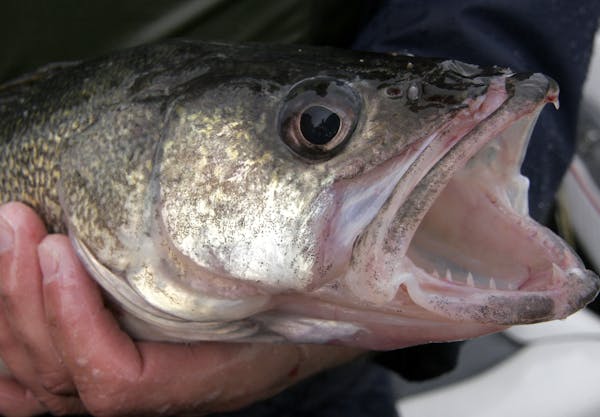A hunting blind can provide comfort and improve your chances of bagging a turkey. Some, however, still prefer the thrill of being in the wide open.
Hunkered in a small, tent-like hunting blind, I watched with frustration as a big tom turkey strutted and gobbled all morning in a distant field, then strode past, well out of shotgun range, chasing two hens.
He ignored my plaintive calls and two decoys. After five days of turkey hunting in three states, it looked as if the results in Minnesota would be the same: No bird.
Nibbling on a breakfast bar, I waited. Forty minutes later, seeing nothing, I turned and peeked out the screened opening behind me, just in case that gobbler had changed his mind.
And there he was, his copper feathers glistening in the sunshine, silently and slowly ambling my way.
My heart pounded as I collapsed my chair, cleared away my gear and quietly pivoted 180 degrees. The gaudy bird strode closer, and at 27 yards fell to one well-placed shot.
Soon, wild turkey would be roasting in my oven.
My success last May underscored the benefit of using a blind to hunt wild turkeys: Without it, I almost certainly wouldn't have bagged that bird. It concealed my movement, allowing me to turn around and get a shot. I couldn't have done that nestled against a tree.
But there are drawbacks to hunting gobblers from a blind, too.
Here are some pros and cons:
Pros Conceals movement
A good blind conceals movement, and outwaiting a wary bird often is the difference between success and failure. I eat and drink — and yes, even pee — in my pop-up blind, without spooking keen-sighted gobblers. I can stand up and stretch, too. That means I'm likely to stay in my blind longer, giving me a better chance of bagging a turkey.
A blind is an especially good idea if you're hunting with a youngster or beginner.
"Kids don't tend to sit still very long,'' said Keith Carlson, 52, of Anoka, a longtime turkey clinic instructor and president of the National Wild Turkey Federation's Anoka County chapter. "A blind really helps. If you're introducing any person to the sport, it's the only way to go.''
And if you're hunting with a partner, a two-person blind can be a fun way to spend a day in the woods, whispering quietly and watching spring unfold. (Bowhunters, of course, often rely on a blind to hide their movement.)
Foul weather
Blinds also are great for hunting in the rain or snow. I sat comfortably in mine last April during a rare sleet storm in Kansas. Sitting in the open that day would have been ugly. And I've sat dry inside my blind during a hard rain in Wisconsin. I use slate and box calls that won't work if they get wet. A blind allows hunters to stay in the woods longer, improving their odds of bagging a bird.
Safety first
I would argue a blind is safer than hunting in the open, especially if you're hunting public land. It's hard to be mistaken for a turkey if you're concealed inside a blind.
Cons An investment
A good blind isn't cheap. And you generally get what you pay for. They run roughly $60 to $400. The higher-end models usually have better quality materials.
"The zippers are quieter and stronger; the inexpensive ones have cheaper zippers and more nylon,'' said Carlson.
"You really want a good one. Less expensive blinds tend to flap in the wind and make noise; turkeys don't like that.''
Mobility affected
Blinds also are an effort to carry. Most weigh between 20 and 30 pounds — or about what a big gobbler might weigh if you're lucky to bag one. You already need to carry your shotgun, a pack with decoys, calls and something to eat and drink.
That means they might be impractical if you have to hike in a mile or more to your hunting spot, or if you're planning on "running and gunning'' — moving from spot to spot.
Last May, after bagging my bird, I had to lug my blind, folding chair, pack, hunting vest, shotgun and gobbler about a half-mile to my vehicle.
It was a chore.
If you have private land to hunt, it makes sense to set up your blind in a good spot the night before your hunt and leave it, Carlson said.
"That's the way I do it,'' he said. "I know there are people who carry it in the morning and set it up and get away with it, but to me it's too much commotion in the morning.''
Wind causes problems
Depending on the quality of your blind, wind also can be a problem. I've had to take my blind down at midmorning because the wind was too strong. That's why even if you use a blind, be prepared to hunt without one.
Sight restricted
While I like the concealment a blind offers, I do tire of peering through a mesh screen for hours. It's like looking through a dirty window. Sitting in the open offers an unobstructed view of the woods and approaching turkeys.
"You can see a lot better,'' Carlson said.
And some would argue sitting against a tree, in the open, offers an even greater thrill when a tom starts strutting your way. You realize one twitch of your head or hand can send the sharp-eyed turkey scurrying.
That said, Carlson said he believes more hunters are using blinds these days for one reason:
"I think your success rate is higher using a blind.''
Doug Smith • 612-673-7667

Former Hopkins basketball star transferring from Michigan to U

Can things get better for the Wild after a disappointing season?
NBA Playoffs 2024: Before Game 1s on Saturday, a pair of Game 7-type matchups on Friday

